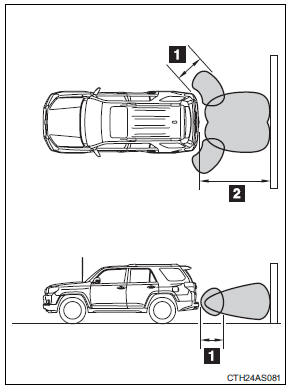Toyota 4Runner: Detection range of the sensors

1. Approximately 1.6 ft. (50 cm) 2. Approximately 4.9 ft. (150 cm)
The diagram shows the detection range of the sensors. Note that the sensors cannot detect obstacles that are extremely close to the vehicle.
The range of the sensors may change depending on the shape of the object etc.
Intuitive parking assist can be operated when
Vehicles without a smart key system: The engine switch is in the “ON” position and the shift lever is in R.
Vehicles with a smart key system: The “ENGINE START STOP” switch is in IGNITION ON mode and the shift lever is in R.
Sensor detection information
• Certain vehicle conditions and the surrounding environment may affect the ability of a sensor to correctly detect an obstacle. Particular instances where this may occur are listed below.
• There is dirt, snow or ice on a sensor.
• A sensor is frozen.
• A sensor is covered in any way.
• The vehicle is leaning considerably to one side.
• On an extremely bumpy road, on an incline, on gravel, or on grass • The vicinity of the vehicle is noisy due to vehicle horns, motorcycle engines, air brakes of large vehicles, or other loud noises producing ultrasonic waves.
• There is another vehicle equipped with parking assist sensors in the vicinity.
• A sensor is coated with a sheet of spray or heavy rain.
• A bumper or sensor receives a strong impact.
• The vehicle is approaching a tall or right-angled curb.
• In harsh sunlight or intense cold weather • A non-genuine Toyota suspension (lowered suspension etc.) is installed.
In addition to the examples above, there are instances in which, because of their shape, signs and other objects may be judged by a sensor to be closer than they are.
• The shape of the obstacle may prevent a sensor from detecting it. Pay particular attention to the following obstacles:
• Wires, fences, ropes, etc.
• Cotton, snow and other materials that absorb sound waves
• Sharply-angled objects
• Low obstacles
• Tall obstacles with upper sections projecting outwards in the direction of
your vehicle
When the system malfunctions
If a malfunction occurs and no obstacles have been detected, the indicator flashes and the buzzer sounds for approximately 7 seconds.
If the indicator comes on and stays on after that, have the vehicle inspected by your Toyota dealer.
Customization that can be configured at Toyota dealer
Settings (e.g. buzzer volume) can be changed.
(Customizable features )
Certification For vehicles sold in the U.S.A.
This device complies with Part 15 of the FCC Rules. Operation is subject to the following two conditions; (1) This device may not cause harmful interference, and (2) This device must accept any interference received, including interference that may cause undesired operation.
For vehicles sold in Canada
This ISM device complies with Canadian ICES-001.
Cet appareil ISM est conforme a la norme NMB-001 du Canada.
CAUTION
Caution when using the intuitive parking assist-sensor
Do not attach any accessories within the sensor range.
Doing so may result in the vehicle being unable to be driven safely and possibly cause an accident.
NOTICE
Notes when washing the vehicle
Do not apply intensive bursts of water or steam to the sensor area.
Doing so may result in the sensor malfunctioning.
 The indicator and buzzer
The indicator and buzzer
When a sensor detects an obstacle, the direction of the obstacle is indicated
and the buzzer sounds.
Sensor operation and distance to an obstacle
The system operates when the vehicle approaches an ...
 Rear view monitor system (rear view mirror-attached type)
Rear view monitor system (rear view mirror-attached type)
The rear view monitor assists the driver by displaying an image of the
area behind the vehicle while reversing. The image is displayed in reverse on
the screen. This reversed image is a similar im ...
Other materials about Toyota 4Runner:
Problem Symptoms Table
PROBLEM SYMPTOMS TABLE
HINT:
Use the table below to help determine the cause of problem symptoms.
If multiple suspected areas are listed, the potential causes of the symptoms
are listed in order of probability in the "Suspected Area" ...
Taillight Relay Circuit
DESCRIPTION
This is the power source circuit of the clearance warning ECU assembly.
WIRING DIAGRAM
CAUTION / NOTICE / HINT
NOTICE:
Inspect the fuses for circuits related to this system before performing the following
inspection procedure.
PROCEDURE
...
0.0261
